[Next] [Previous] [Top]
A shift in algebra, development and implementation: varia-abilities
Mieke Abels
Freudenthal institute
Utrecht
The Netherlands
ALGEBRA- W12-16
The W12-16 project was a curriculum innovation project in the Netherlands for the lower grades in secondary education for students from age 12 to 16. The curriculum development was carried out by order of the ministry of education by the Freudenthal Institute and the Institute for Curriculum Development (SLO). The project lasted from 1987 to 1992 and will be implimented at all of the schools in the country in the period 1993-1997. In-service training and support is provided by the Cooperation group of the General Pedagogic Study Centre (APS). During the whole period of development and implementation teacher organizations, researchers, publishers and the national institution for examinations were also involved. The outline shows to which grades and school types the innovation refers..
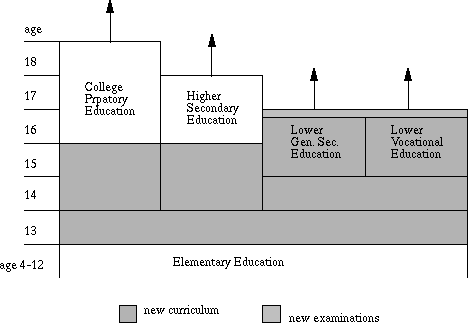
The development of Realistic Mathematics Education started in primary education in the late sixties and early seventies. In this theory or philosophy mathematics is considered as a human activity (Freudenthal, 1991). The main idea is to develop sense making ways for learning and teaching sense making mathematics. The approach of Realistic Mathematics Education was propagated and elaborated by Freudenthal, and staff of the Freudenthal Institute (Treffers 1987, De Lange 1987, Streefland 1991, Gravemeijer 1994, van den Heuvel 1996). One of the motives for the development and implementation of the new program 12-16 was to complete the innovation of Dutch mathematics education. In primary education more and more school are working with "realistic text books," and in recent years new mathematics curricula have been introduced in the upper grades of secondary education:
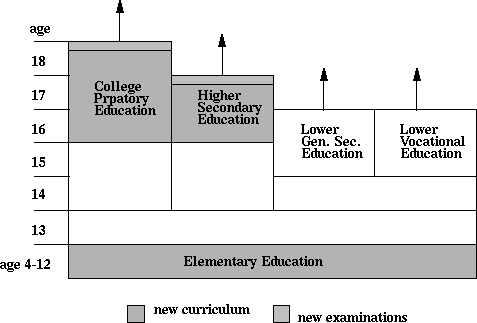
There were more motives for changing the curriculum for the agegroup 12-16 than "bridging the gap" between primary education and upper secondary. Other motives were a changing society, which uses more and more mathematical visualizations and reasonings. Technological developments can not be ignored, calculators and computers should be new tools in mathematics education. And finally new insights about learning and teaching mathematics played an important role in the development of the new curriculum. The use of realistic contexts or situations as a base to start the development of mathematical concepts and skills, and as a field to apply these mathematic concepts and skills should be a leading theme in mathematics education. The experiences students have and the concepts they have developed when they enter secondary school should be used as a starting point, in order to develop their insight in a meaningful way. This all resulted in a new curriculum that shows the following major characteristics:
- Much attention for the use of mathematics in day to day situations and professional situations.
- Mathematics educations takes place in situations which are recognizable for students.
- Stimulation of an investigative attitude on the part of the student.
- Formal techniques are not a goal in themselves.
During the project special attention has also been devoted to making mathematics attractive to girls. This has among other been achieved by choosing contexts and application situations which reflect the full expanse of everyday life.
The strands in the new curriculum were elaborated more or less separately and intertwined at the end of the project. So the curriculum is not partitioned in separate courses like algebra, statistics, number, or geometry. The develop of the algebra strand was one of the most difficult ones. Although the content merely overlaps the content of the old program, an important shift took place towards new methods and techniques for problem solving. The traditional algebra program was structured following an increasing mathematical complexity: first linear functions, solving linear equations, then quadratic functions and quadratic equations, and so on. Much time was spend on manipulations with variables and expressions, which were often more complicated than necessary to solve problems about lineair and quadratic functions. Also many techniques were practized rather isolated. The following scheme illustrates how the old program was stacked
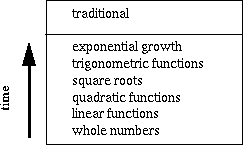
In the new algebra program the importancey of the study of relationships between variables remained, but with different emphasis. First of all, the relationships are presented in realistic problems and are not only linear and quadratic relationships as in the traditional curriculum. Also exponential and more complex relationships are explored, and the concepts of all different relationships are developed parallel to each other together with strategies that can be applied in more than one specific situation. This approach of algebra is a shift from purely disjunct vertical mathematization to horizontal mathematization (Treffers 1987). It can be seen as a change of the time factor (Goddijn 1990)
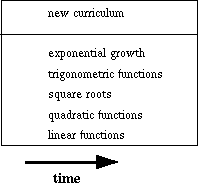
The new curriculum emphasizes techniques to solve problems that can be applied in different situations for different types of relationships. Formal methods are developed from concrete situations, for instance for the solving of equations. The different representations of the relationships- descriptions in words, graphs, tables and formulas- play an important role in this development. Skills to translate one representation into another, to see the similarities and differences among different representations as well as the advantages as the disadvantages are developed and used throughout the curriculum. Also other methods who can be used to solve problems who are represented by tables and graphs are getting more attention, for example interpolation and extrapolation.
The presentation of Algebra12-16 in the working group will focus more on these different representations and techniques for problem solving. Examples of students' work will be used to give some realistic illustrations of different strategies and methods students developed working with the new program and may provoke a discussion. The following example may be considered as a short preview.
Students (age group 12) were asked to look for graphs in newspapers and magazines in order to design a graph-problem by themselves. The purpose of this assignment was, to see how well they could reflect on their study of graphs. Two students used a graph they found in their geography book and made up the following questions. Their questions may reveal the approach that is chosen in the algebra curriculum for studying graphs. Note that students' choice of words are translated as litterally as possible.
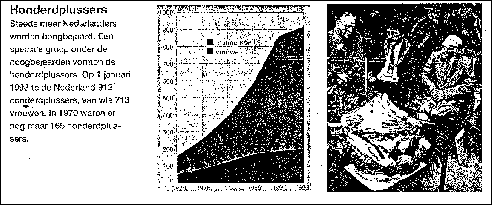
Are there more women or men older than 100 years?
- Is the graph of the women regular or not?
- Fill in: In 1976 there were ... male "hunderd-plus" and in 1993 ... male "hundred-plus."
- When did the number of hundred-plus women increase the most?
- When did the number of hundred-plus men increase the most?
- What can you tell about the men, what about the women?
- If it was not indicated which graph belonged to the men and which to the women, how could you know?
- Is this a good graph? Why (not)?
References
Freudenthal, H.F. (1991), Revisiting Mathematics Education, China Lectures, Dordrecht, The Netherlands: Kluwer Academic Press
Goddijn, A.J., K.P.E. Gravemeijer, J. ten Hove, P. van der Zwaart (1990), En de variabelen, hoe staat het daarmee? , In: Nieuwe Wiskrant, tijdschrift voor nederlands wiskundeonderwijs, volume 10, number 1. Utrecht, The Netherlands: OW&OC, pp. 12-20
Gravemeijer, K. (1994), Developing Realistic Mathematics Education, Utrecht, The Netherlands: CD-B Press/Freudenthal institute
Heuvel-Panhuizen, M. van den (1996), Assessment and Realistic Mathematics Education, Utrecht, The Netherlands: CD-B press, Freudenthal Institute
Lange, J. de (1987), Mathematics, Insight, and Meaning, Utrecht, The Netherlands: OW&OC/ Freudenthal Institute
Streefland, L. (ed) (1991), Realistic Mathematics Education in Primary School, Utrecht, The Netherlands: CD-B Press/Freudenthal institute
Treffers, A. (1987), Three Dimensions. A Model of Goal and Theory Description in Mathematics Education, The Netherlands, Dordrecht: Kluwer Academic Publishers
ICME8 - WG13 - 02 JUL 96
[Next] [Previous] [Top]
Generated with CERN WebMaker




